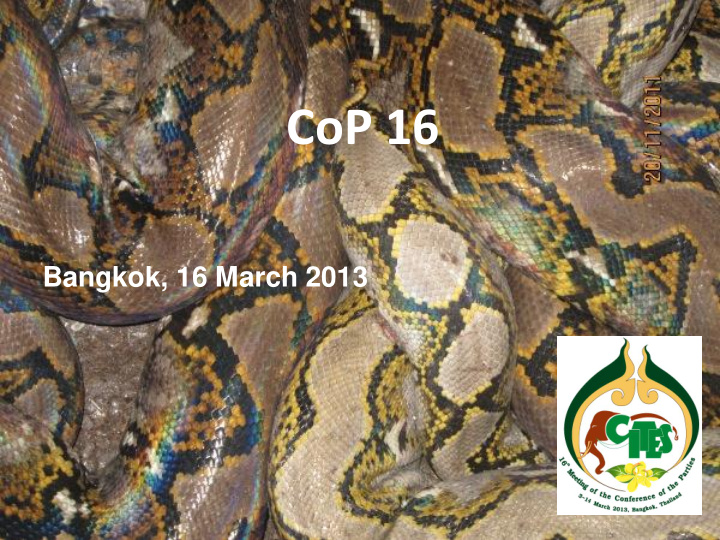



CoP 16 Bangkok, 16 March 2013 Bangkok, 16 March 2013 Bangkok, 16 March 2013
Ralph Arbeid Ralph Arbeid International leather value chain consultant International leather value chain consultant Co- author ITC’s Trade in SE Asian Python skins Co- author ITC’s “Trade in SE Asian Python skins”
The Trade 1. Manufactured products exceeding US$ 3 bn per year 2. More that 75% top end fashion industry 3. Highly sensitive to fashion trends and demands
Traceability – why: 1. Elimination (drastic reduction) of illegal trade 2. Facilitate real-time CITES control over export 3. Objective instrument of verification on captive breeding 4. Facilitate MA control and custom’s verification
Traceability – why (2): 5. Contribution to improve animal welfare 6. Safeguard Exporters and Importers 7. Consumer reassurance on sustainability, animal welfare and legality 8. Credible substitution of population studies 9. Incentive to elimination of excessive and incomprehensible bureaucracy (e.g. Italy)
Traceability – what system? 1. Identification at (farm) slaughter level Area of capture or name farm Date Species Sex Length of the skin 2. Simple and affordable 3. Real-time on-line registration with CITES database 4. Mobile technology 5. Linked to zero tolerance for unidentified skins 6. Applicable up to the manufactured product
System options 1. Barcodes (Teflon on Aluminium) 2. RFID 3. DNA RFID 4. Combination barcode and RFID 5. Subcutaneous micro chip
Priorities: - Protection from fraud - Simple distribution - Easy application - Sustainable in industrial production - Affordable - Identification (and regulation) of undeclared and pre-CITES stocks
Linkage of Traceability to Sustainability
Population Study
Science or Trade
Science or Trade 1. Impossible cover region 1. Regionwide coverage 2. Time limit 2. Unlimited in time 3. Expensive 3. Cost efficient 4. Night hunters 4. Effective numbers 5. Verifiable (CITES dbase) 5. Shy and hiding 6. Highly realistic 6. Inconclusive 7. Extrapolations 7. Exact figures
Data collection from private sector 1. Challenging being extremely sensitive data 2. Origin of skins Indonesia, but can be easily extended 3. Private sector only 4. Six major tanneries in Italy, France and Spain My heartful thanks and appreciation to the 6 Italian and Spanish tanneries that actively cooperated in full transparency for their trust and confidence by sharing their extremely sensitive commercial data!
Trade Statistics 2004 - 2012* Total length in meters per width category Year Total Mt Skins Avg Length 2012 182.127 52.775 3,45 2011 142.007 42.685 3,33 2010 121.378 36.289 3,34 2009 53.380 15.750 3,39 2008 127.668 38.575 3,31 2007 158.180 46.127 3,43 2006 97.681 29.182 3,35 2005 180.076 56.643 3,18 2004 43.400 13.152 3,30 Total 1.105.899 331.178 3,34 The info is provided by 6 major tanneries prepared to submit sensitive data
Quantity of skins over 9 years* 60'000 50'000 40'000 30'000 20'000 10'000 0 2012 2011 2010 2009 2008 2007 2006 2005 2004 1 * Related to data received from 6 major tanneries
Average length of skins over 9 years* 3.50 3.45 3.40 Average length per year 3.35 3.30 3.25 3.20 3.15 3.10 3.05 3.00 2012 2011 2010 2009 2008 2007 2006 2005 2004 * Related to data received from 5 major tanneries
Conclusions Traceability serves a dual purpose: Legality Sustainability
Thank you r.arbeid@gmail.com
Recommend
More recommend